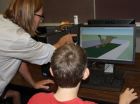Now, scientists at Temple University School of Medicine may have figured out a way to corral this stem cell activity and stunt further cancer development. In a series of experiments in mice with cancer and in cancer cells, they have shown that they can block the process by which leukemia stem cells repair themselves by targeting a particular protein, RAD52, which the cells depend on to fix genetic mistakes. The findings may lead to a new strategy to help overcome drug resistance that hinges on cancer stem cells gone awry.
The researchers report their findings December 9 in a plenary scientific session at the 54th American Society of Hematology Annual Meeting and Exposition in Atlanta.
"We would like to eradicate the leukemia stem cells and cure patients with CML," said senior author Tomasz Skorski, MD, PhD, Professor of Microbiology and Immunology at Temple University School of Medicine. "We took advantage of the fact that remaining leukemia stem cells accumulate lots of lethal DNA lesions, but they don't die because they can repair them very efficiently. We attacked the DNA repair pathway in a way that is not going to harm normal cells, which have a different repair mechanism than leukemia cells."
Targeting Key Repair Protein
The trick, the researchers say, lies in a process called "synthetic lethality," which is defined as a genetic combination of mutations in two or more genes that leads to cell death, whereas a mutation in any single gene does not. In synthetic lethality, cancer cells may accumulate mutations fostering their growth, enabling them to sidestep certain types of anticancer treatments. But these same genetic mutations may make them vulnerable to a different type of therapy.
In CML, an enzyme called ABL1 goes into overdrive because of a chromosomal mix-up that occurs in bone marrow stem cells that are responsible for the generation of all blood components. The genes ABL1 and BCR become fused and produce a hybrid BCR-ABL1 enzyme that is always turned on. This overactive BCR-ABL1 protein drives the excessive production of white blood cells that is the hallmark of CML.
CML is also marked by genomic instability, which can result in mutations that cause the cancer to become resistant to potent targeted anticancer drugs called tyrosine kinase inhibitors (TKIs), such as imatinib (Gleevec), leading to disease relapse and perhaps to the deadlier blast stage of the disease. One of the most common types of DNA damage is a "double-strand break," which entails severing both of the complementary strands of DNA that make up the double helix.
In CML cells, the BCR-ABL1 protein shuts down the main DNA repair system and leukemia cells have to rely on a backup pathway for repair. Previous experiments in mice bone marrow cells lacking RAD52, a key protein in the backup system, showed that its absence abrogated the development of CML, proving that CML DNA repair depended on RAD52.
"Earlier research by Temple investigators found that the presence of the RAD52 gene is a key factor for the development of the leukemia," explained first author Kimberly Cramer, PhD, a postdoctoral fellow in the Department of Microbiology and Immunology at Temple's School of Medicine. The researchers took advantage of the fact that when the RAD52 protein is mutated in some way, it can no longer bind to DNA, which is crucial to fixing broken DNA. Using the same bone marrow cells that lacked RAD52, they re-expressed either normal RAD52 or, more importantly, either of two mutated forms of RAD52 to see what would happen when RAD52 could not bind to DNA anymore.
They found that when the mutant RAD52 proteins were expressed in the presence of BCR-ABL1, there were more double-strand breaks formed, which was accompanied by a decrease in the survival and expansion of leukemia stem cells. The team then used an "aptamer," a peptide that mimicked the area where the RAD52 protein binds to DNA, to see the effects of blocking RAD52 from binding to DNA. The investigators found that when the aptamer was added to BCR-ABL1-positive bone marrow cells, RAD52 was prevented from binding to DNA and the leukemic bone marrow cells accumulated excessive double-strand breaks and eventually died. The aptamer had no effect on normal cells.
Personalizing Therapies
"With this treatment in hand, we eventually hope to generate a small molecule inhibitor with which we will be able to target leukemia patients based on their oncogenic profiles," Dr. Cramer said.
Dr. Skorski added that such profiling strategies could likely be extended to other cancers as well. "We've started to use microarrays to look at the expression profiles of the DNA repair genes in other cancers, and based on these profiles, predicted if they would be sensitive to 'synthetic lethality' triggered by our approach," he said. "We'd like to personalize treatments."
### Other investigators who contributed to the research include Artur Slupianek, Temple University School of Medicine; Kimberly Haas and Wayne Childers, Temple University School of Pharmacy; Tomasz Sliwinski, University of Lodz, Lodz, Poland; and David Irvine and Mhairi Copland, University of Glasgow, Glasgow, United Kingdom; Michelle Padget, Kara Scheibner and Curt Civin, University of Maryland, Baltimore; and Jaewoong Lee and Marcus Muschen, University of California, San Francisco.
The research was supported by funding from the National Institutes of Health grants 1R21CA133646 and 1R01CA89052, and from Temple University.
About Temple Health
Temple Health refers to the health, education and research activities carried out by the affiliates of Temple University Health System and by Temple University School of Medicine.
Temple University Health System (TUHS) is a $1.4 billion academic health system dedicated to providing access to quality patient care and supporting excellence in medical education and research. The Health System consists of Temple University Hospital (TUH), ranked among the "Best Hospitals" in the region by U.S. News & World Report; TUH-Episcopal Campus; TUH-Northeastern Campus; Fox Chase Cancer Center, an NCI-designated comprehensive cancer center; Jeanes Hospital, a community-based hospital offering medical, surgical and emergency services; Temple Transport Team, a ground and air-ambulance company; and Temple Physicians, Inc., a network of community-based specialty and primary-care physician practices. TUHS is affiliated with Temple University School of Medicine.
Temple University School of Medicine (TUSM), established in 1901, is one of the nation's leading medical schools. Each year, the School of Medicine educates approximately 720 medical students and 140 graduate students. Based on its level of funding from the National Institutes of Health, Temple University School of Medicine is the second-highest ranked medical school in Philadelphia and the third-highest in the Commonwealth of Pennsylvania. According to U.S. News & World Report, TUSM is among the top 10 most applied-to medical schools in the nation.

